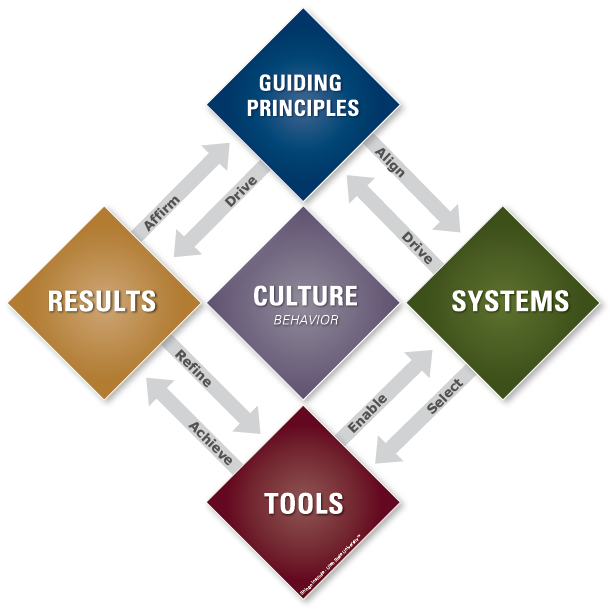Do your tools and systems align with your goals?
An important part of organizational improvement is ensuring that existing systems and tools are utilized to their fullest potential. Businesses across the value chain can benefit from a wide range of strategies for determining how to enhance a process. In the long run, this leads to an organizational culture that produces certain results.
The result is a unique set of values, norms, and practices for getting things done with the help of employees at each company. If the organization wishes to alter these outcomes, it will have to alter its people’s culture and behavior. The ideal behaviors required to achieve ideal results can be informed only by principles.
What Is Shingo’s Business Model?
The Shingo model may be used as a standard for achieving excellence at the highest level. Using it, an organization’s many parts may be brought together under one set of guiding principles and a tried-and-true technique for transformation.
What is the principle of the Shingo model?

Building a long-term culture of organizational excellence is possible with the help of the Shingo Guiding Principles. The Guiding Principles diamond divides the principles into three distinct dimensions:
-
- Cultural Enablers:
- Leading with humility is a characteristic shared by many of the most successful people in business today.
- Every employee in a company should have a strong sense of respect for each other and for the corporation as a whole.
- Continuous Improvement: All outcomes are the result of a process, which is why continuous improvement is so important. Good individuals can’t generate excellent results with terrible processes since it’s almost impossible. When something goes awry or a product or service fails to meet expectations, we tend to point the finger at the individuals involved. The problem is frequently found in a flawed method, not in the individuals involved.
- Enterprise Alignment – Repeated cycles of experimentation, direct observation, and learning are the result of innovation and improvement. We can always learn more about the world around us if we keep looking for new ideas, even if they don’t work out.
- Cultural Enablers:
How Is Shingo Model Implemented?
In order to achieve operational excellence, a firm can choose from three different approaches.
- Manufacturing with a Focus on Efficiency (Lean Manufacturing) – The primary goal of lean manufacturing is to cut costs by removing waste from the production process. There are eight types of waste – or non-value-added activities – that must be eliminated for a company to achieve operational excellence according to lean manufacturing, which is inspired by the Toyota Production System (TPS).
-
- Overproduction
- Long wait times
- Excess Transporation
- Variable techniques of processing
- Excess inventory
- Too much motion
- Too many errors
- People’s untapped inventiveness
- Six Sigma – Founded on the universal principles of the Juran Trilogy, Lean Six Sigma provides a comprehensive set of methods and tools that help organizations reduce costs and improve quality, with the ultimate goal of continuous value creation for customers. There are five major phases of Lean Six Sigma improvement initiatives that follow the DMAIC methodology:

- Kaizen –To put it another way, the phrase “improvement” or “change for the better” means “kaizen” in Japanese. Through daily kaizen, which refers to the small incremental improvements that an organization makes every day, you can make sure that your company is always improving.
At Big Rocks Engineering, we believe in continuous improvement as a company and have implemented a variety of effective programs over the years that have helped make our business a better place to work.
What is your experience with the Shingo Model? Have you used it in your organization?




